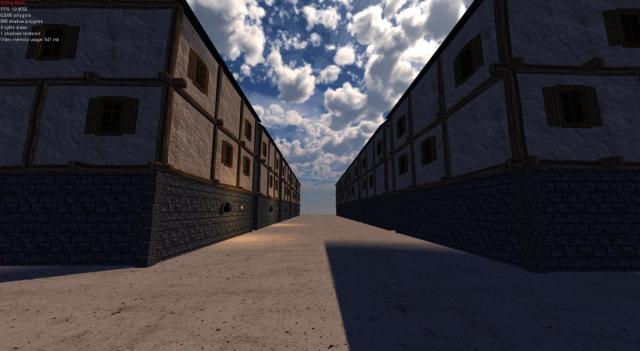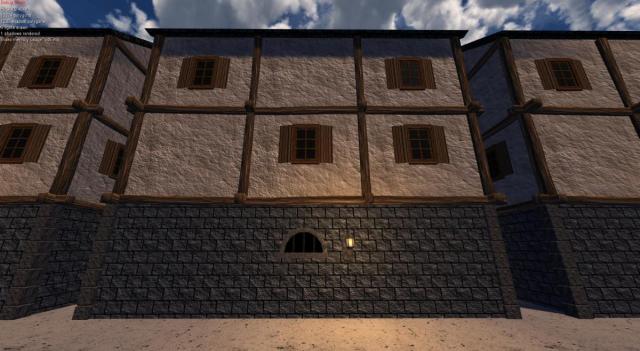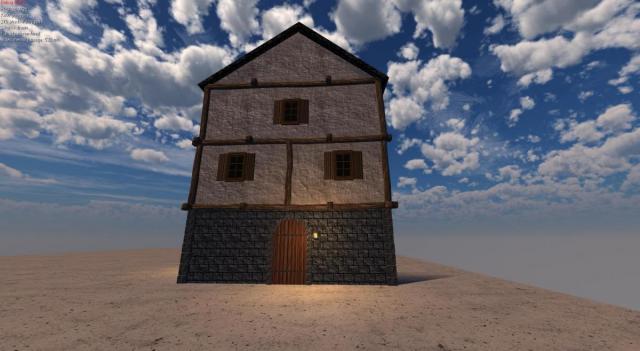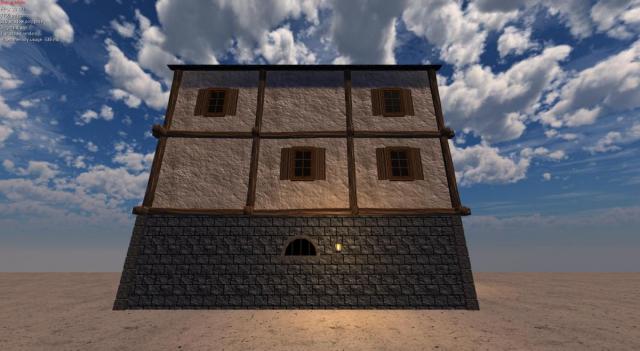Search the Community
Showing results for tags 'Performance'.
-
I'm planning to use LOT'S of decals in my project. I will use them to for signs, labels, dirt etc. My question is, before I go ahead, do they eat lot of processing power? What if I have a prefab with ten decals and then I have that prefab used in 20 different places? Even hundreds? Well, yes best way is to test it But wanted to ask if it is just plain stupid thing to do one should not even try. Another question, can we have emissive decals? I created "Emissive decal" by applying it over emissive surface (needed to reverse the decal though), but although it works, It is not usable in many scenarios. And yet another question, how would you create a piece of paper with text on it? I planned to use decal for that, but it obviously looks like painted to the surface, not separate piece of paper.
-
Hi there, I am wondering if I am doing something wrong, or if I expect too much from Leadwerks... I built a small medivial house, just to play around. Soon I recognized that I got trouble with perfromance, very low FPS in Debug and normal run mode. So I started testing Leadwerks Performance a bit. I dont have experience with other engines, Leadwerks is the first I get my hands on. Well to move on, I rebuilt the whole house, creating models with less polygons and I also disabled most of the shadows. I posted a view screenshots where you can see my poly count and fps rate. I dont really understand why its lagging. Even if I just place a single house I get only 30 FPS. Ok the textures need some optimization but about 500 MB memory usage in summary isnt that much, even if its much for those few houses. I am a bit disappointed. How should I ever create a livley city when the performance is that bad? I searched the web for what poly counts are common and found out that 10k polygons are ok for a detailed character, for a prop its suggested to be 500 -1.5k. So 7k for a whole house really isnt much. So am I doing something wrong? Because I cannot believe Leadwerks performance is that bad. I need to add that if I decrease the resolution of my project to standart (something like 1024 x 768) it runs smoother, but for the city map I still get FPS drops and a maximum of 30 - 40 FPS which is not optimal. But still it needs to run smooth on a 1920 x 1080 resolution! I also want to add that If I activate static shadows for all the props build around the house (Planks, Lamp, Windows, etc.) the framerate is like hell. I dont think I can do something so wrong with just a single house and some textures, but I am glad if I am wrong A few more Infos: - I dont use any extra shaders - there are two point lights per house - I set the screen resolution to 1920 x 1080 - even if I export the game and run it I get 20 - 30 FPS (for the "city" map) - My specs: Intel Core i5-3570K CPU @ 3.40 GHz, 8 GB Ram, Windows 7 64 Bit, Nvidia Geforce GTX 960 4G (4 GB Vram) - I use specular and normalmaps for all textures - The houses dont have an interior I really appreciate if you are able to help me. If you need some more info please tell me. I just want to make a awesome game...
- 19 replies
-
- Performance
- Art
-
(and 2 more)
Tagged with:
-
http://pastebin.com/yQ2jHPii > I put my script on pastebin for better overview. This is the script I attached to a turret . Basic explaination: It ckecks for enemies nearby and alligns itself to them, calls shoot() function once in a while. The Bullet itself is only for the visual. To hurt the enemy, I will later acces the enemy script trough the turret and call a hurt function. In the start funcion I set up an emitter which should look like a bullet flying . I want to know how i properly let the emitter play , and have multiple bullets at one time. ( or just how to play it , i can make the bullet run faster so it would be no problem if it gets resetted). I made an attempt in the Shoot() function, but i cant see anything inside the game. 2 The performance is still a littlebit low, I can spawn ~30 turrets at normal fps and when I spawn more it gets lower (not over time, the more turrets the less fps). I personally think its caused by my computer or lua, but still if you can find anything that could cause less performance please tell.
-
I'm running into a huge issue, I can't wrap my head around it. Whenever I compile the Lua interpreter (Visual Studio Express 2013, Release mode, Windows-32 bit), I get back an exe about 5.5 MB large. The Lua interpreter that comes in each project is only 4.5 MB large. This fact alone wouldn't be a huge issue, but I have a feeling that it is contributing to perfomance issues. Here's the problem: If I create a map with too many entities, my compiled interpreter will exponentially decrease it's framerate until the game basically freezes. The same map used on the Lua interpreted version does not lead to that (the game runs fine at a constant framerate). I don't think it is a memory leak because if I remove instance of the same mesh, the problem goes away (which means it doesn't have to do with batches either, since that is constant). I've even loaded the map without Lua scripts and I still get the same issue. It sounds like some sort of thrashing is going on due to less memory being allocated, but I'm not sure. I'm also only using 2 lights, and about 120k polys (with a similar amount of shadowed polygons). I think I was using between 400 MB and 700 MB of VRAM, but none of these should be the issue here either as I have 2 GB or VRAM. Anyway, any possible solutions or compiler settings/flags that I might be missing here?
-
I find it really strange that I'm getting really low FPS on all of the maps that I make, I usually have around 5-10 fps when the map is fully finished, and the bad thing is, I'm not the only one with this problem. I get that my map is intense in terms of lights and whatnot but my specs should allow me to run the game at 60+fps. I thought that this issue would be a bit better with 3.4 but it's the same as 3.3 Oh and I've published the game and ran it, same deal. Low FPS for days.
- 38 replies
-
- Performance
- Low frames
-
(and 1 more)
Tagged with:
-
This might be a pretty obscure question, but I just had a thought as to why I might sometimes get crashes randomly. Anyway, do loaded assets get "cached"? If not, then could loading and releasing assets possibly fragment memory to an extent that could cause a game to crash?
-
- performance
- crashing
-
(and 1 more)
Tagged with:
-
Here is the issue I'm having. I recently updated my map with a ton of new assets. Anyway, I still get about 30 fps, but when I have the number of assets that I now have in the scene, it crashes, particularly when I move the camera to face the more dense areas. Sometimes it even crashes outright. When I remove a few buildings or a few cars, this doesn't happen. I can't upload the map, but maybe this video will help: https://www.youtube.com/watch?v=vRo1zVLjOvk Video Card: GeForce GTX 750 Ti Processor: AMD FX-4130 Also, I thought this might be an occlusion culling bug, but when I disabled it on the entities that I delete at the end of the video, it I still get crashes. It also doesn't really matter what entities I delete. I deleted cars before and this stopped the problem. I would expect a lower FPS maybe, but not a crash. Does anyone have a clue on what might be happening?
-
So, I was trying to find out why my game's framerate wasn't the best, and I came across an unexpected discovery. When I have 6 separate car models in game, the framerate plummets. However, if I use the same car model, the framerate is more reasonable. Anyway, I was just wondering, is this supposed to happen? I mean I only have 6 AI cars currently, but the performance seems a bit low. The FPS drops about 75% (like from 40 fps to 10 fps or something like that) once all 6 models are added.
-
I've noticed during the testing, performance is really bad. Whether it's the AI testing level (3-10 FPS), 2 lights+floor+kicking around a box, or a particle emitter with high particle count, as soon as something starts happening it is visibly choppy. It is bogged down from 200 FPS to around 20 FPS with hardly anything going on, and I don't see why that could be, it's not like many unnecessary things are being rendered. (the moving platform level has more lights and moving shadows, unless that's different because the fixed movement path allows the shadows to be buffered) Now my computer is a bit outdated (i7 860 CPU, GTS 450 GPU, 8 GBs of RAM), but it doesn't seem like it should be having this much trouble just from lighting, especially when I can play other games on medium/high graphics with better performance. I'm not sure if this is a general issue, as I've only tried the Linux version, so it very well could be only an issue on that version of the software.
- 4 replies
-
- performance
- shadows
-
(and 1 more)
Tagged with:
-
So I was reading a something from a post on one of Unity's forums (I'm not interested in the engine, but some of the discussions there are helpful), and atlas texturing seems to be a big thing there. I had no idea that one large texture that combined multiple small textures could improve performance substantially. Anyway, how does Leadwerks draw textures under the hood? Does it go through all draw calls like Unity (and thus atlas texturing is important)? Also, are textures dynamically freed when the last instance of a material is hidden from view? Thanks in advance for any feedback! I'm trying to determine how to best achieve certain levels of performance in the long run.
-
Is Leadwerks designed to handle a lot of unique textures without significant performance drop? I'm just curious because I trying to decide on whether or not to use a bunch of unique textures in my game to a lot add variety. Also, how many unique textures are you using if you are working on a game? I'd be interested to know! Thanks, nick.ace












